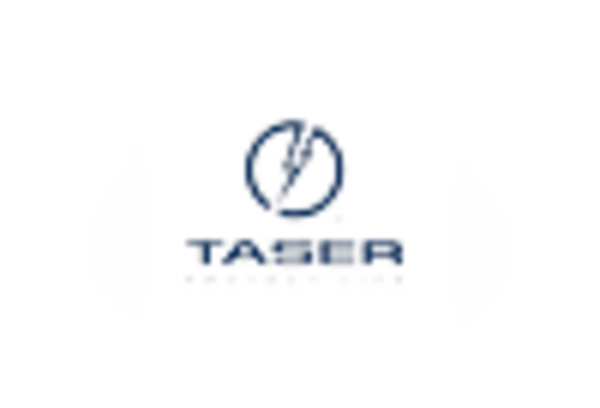Advancements in Technology
Technological advancements play a crucial role in shaping the Global Non-Lethal Weapons Market. Innovations in materials and delivery systems have led to the development of more effective and reliable non-lethal weapons. For instance, the integration of smart technology into non-lethal devices enhances their precision and reduces the risk of unintended injuries. The market is witnessing a surge in the adoption of electroshock weapons and acoustic devices, which are designed to incapacitate individuals without causing lasting damage. As these technologies evolve, they are expected to attract significant investment, with projections indicating that the market could expand to USD 7 billion by 2026. This technological evolution not only improves the efficacy of non-lethal weapons but also addresses concerns regarding their ethical use.
Rising Awareness of Human Rights
The increasing awareness of human rights issues is influencing the Global Non-Lethal Weapons Market. As societies become more conscious of the implications of using lethal force, there is a growing demand for alternatives that can effectively manage conflicts without causing permanent harm. This shift in public sentiment is prompting governments and law enforcement agencies to explore non-lethal options as a means of ensuring compliance with human rights standards. The market is responding to this demand, with projections indicating a potential market size of USD 6.2 billion by 2025. This trend suggests that non-lethal weapons are not only seen as tools for law enforcement but also as instruments that can help uphold ethical standards in policing.
Emerging Security Threats and Terrorism
The rise of emerging security threats, including terrorism and civil unrest, is a critical driver in the Global Non-Lethal Weapons Market. As the nature of threats evolves, law enforcement and military agencies are increasingly recognizing the need for non-lethal options to address these challenges. Non-lethal weapons provide a means to incapacitate suspects without resorting to lethal force, thereby reducing the risk of escalation during confrontations. The market is projected to grow significantly, with estimates suggesting a value of USD 7.5 billion by 2026. This growth is indicative of a broader strategy to enhance security measures while adhering to international norms regarding the use of force. The focus on non-lethal solutions is likely to become more pronounced as agencies seek to adapt to the changing landscape of security threats.
Increasing Demand for Crowd Control Solutions
The rising need for effective crowd control solutions is a pivotal driver in the Global Non-Lethal Weapons Market. As urbanization accelerates and public gatherings become more frequent, law enforcement agencies are increasingly seeking non-lethal options to manage large crowds. This trend is underscored by the fact that the market for non-lethal weapons is projected to reach USD 6.5 billion by 2025, reflecting a compound annual growth rate of approximately 5.5%. Non-lethal weapons, such as tear gas and rubber bullets, are preferred for their ability to disperse crowds without causing permanent harm, thus aligning with public safety objectives. Consequently, the demand for innovative crowd control technologies is likely to continue growing, further propelling the market forward.
Growing Focus on Law Enforcement Modernization
The modernization of law enforcement agencies is a significant driver in the Global Non-Lethal Weapons Market. Governments worldwide are increasingly investing in upgrading their policing strategies to incorporate non-lethal options. This shift is driven by a desire to enhance public safety while minimizing fatalities during law enforcement operations. Reports suggest that the market for non-lethal weapons is expected to grow at a steady pace, with a projected value of USD 6.8 billion by 2025. This growth is indicative of a broader trend towards adopting non-lethal measures in policing, as agencies seek to balance effective law enforcement with community relations. The emphasis on training and equipping officers with non-lethal tools is likely to further stimulate market growth.

















Leave a Comment